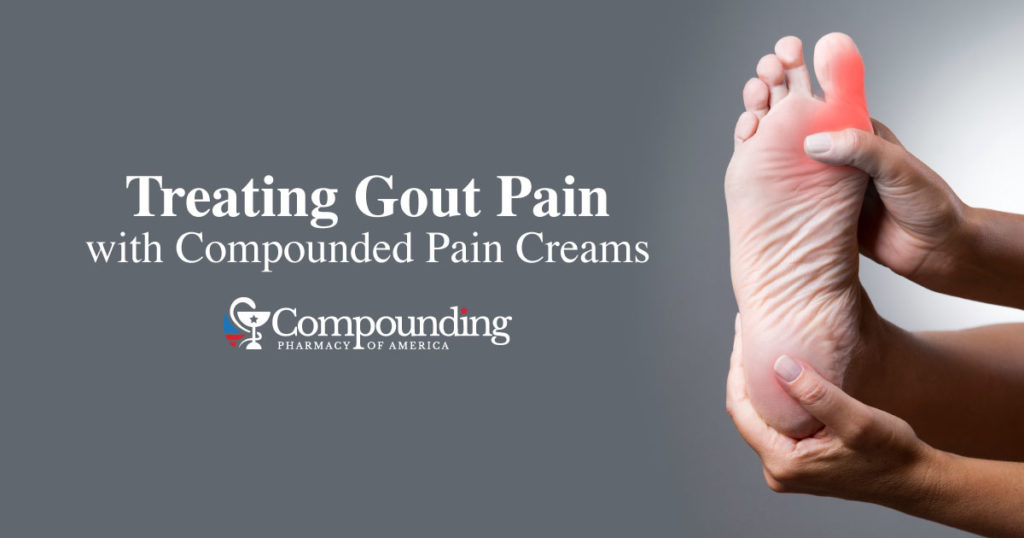
Treating Gout Pain with Compounded Pain Creams
Originally posted on https://compoundingrxusa.com/blog/treating-gout-pain-with-compounded-pain-creams/
Gout is a complicated medical condition that usually affects the feet. It begins with too little uric acid being eliminated out of the body. Excess uric acid in the body builds up and forms crystals in the joints, causing swelling and pain. The pain that typically accompanies sudden gout attacks is intense and can feel as though the foot or joint is on fire. The small joint at the base of the big toe is the most common site for a gout attack. Other joints that can be affected include the ankles, knees, wrists, fingers, and elbows.
Understanding Gout
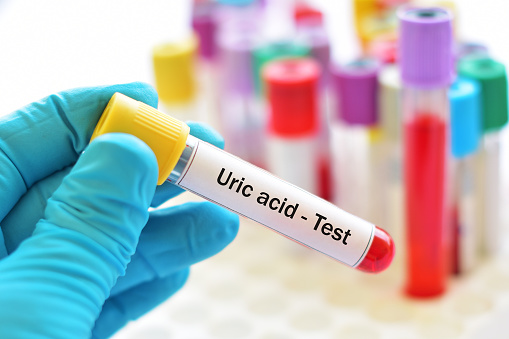
Gout manifests in four stages that vary in their symptoms and treatment options. The first stage of gout is hyperuricemia, too much uric acid in the blood because of inefficient elimination of uric acid from the body. If this is the only symptom, it is asymptomatic hyperuricemia. Not everyone who has hyperuricemia will develop gout, but those that do, need to take be aware of the problems and complications of gout. If hyperuricemia progresses, the second stage known as acute gout manifests.
Second Stage or Acute Gout
Hyperuricemia in the bloodstream can progress to forming urate crystals in the joints of the foot, ankle or knee; once these crystals appear, they cause swelling and moderate-to-intense pain, in what is now acute gout. This can make the joints hypersensitive to touch, even from something as innocuous as one’s own sheets, to the point of excruciating pain. The redness and swelling associated with acute gout makes the feet feel warm to the touch.
Acute gout attacks usually continue appearing over a period of months or years, manifesting very suddenly and lasting several days to weeks, if left untreated and can get more frequent and worse, causing joint damage as well as tendon and other tissue damage.
Third Stage – Intercritical Gout
The period between acute gout attacks is interval gout, or third stage gout. Also known as intercritical gout, the third stage is also asymptomatic. Despite the absence of pain, urate crystals are still being deposited in the joints.
Fourth Stage – Chronic Tophaceous Gout
Finally, chronic tophaceous gout, or fourth-stage gout, occurs when gout is left untreated for too long. Most people do not get this far with proper medication and treatment. Often taking several years or more than a decade to develop fully, chronic tophaceous gout entails hard nodules called “tophi” developing in the joints and tissues surrounding the joints.
Over time, tophi can do permanent damage to the joints and is the most debilitating, causing skin ulcers to appear. This is extremely rare and only if left untreated for decades. Tophi also often appear in other parts of the body, such as the fingers and ears. Permanent kidney damage at this point is also a possibility.
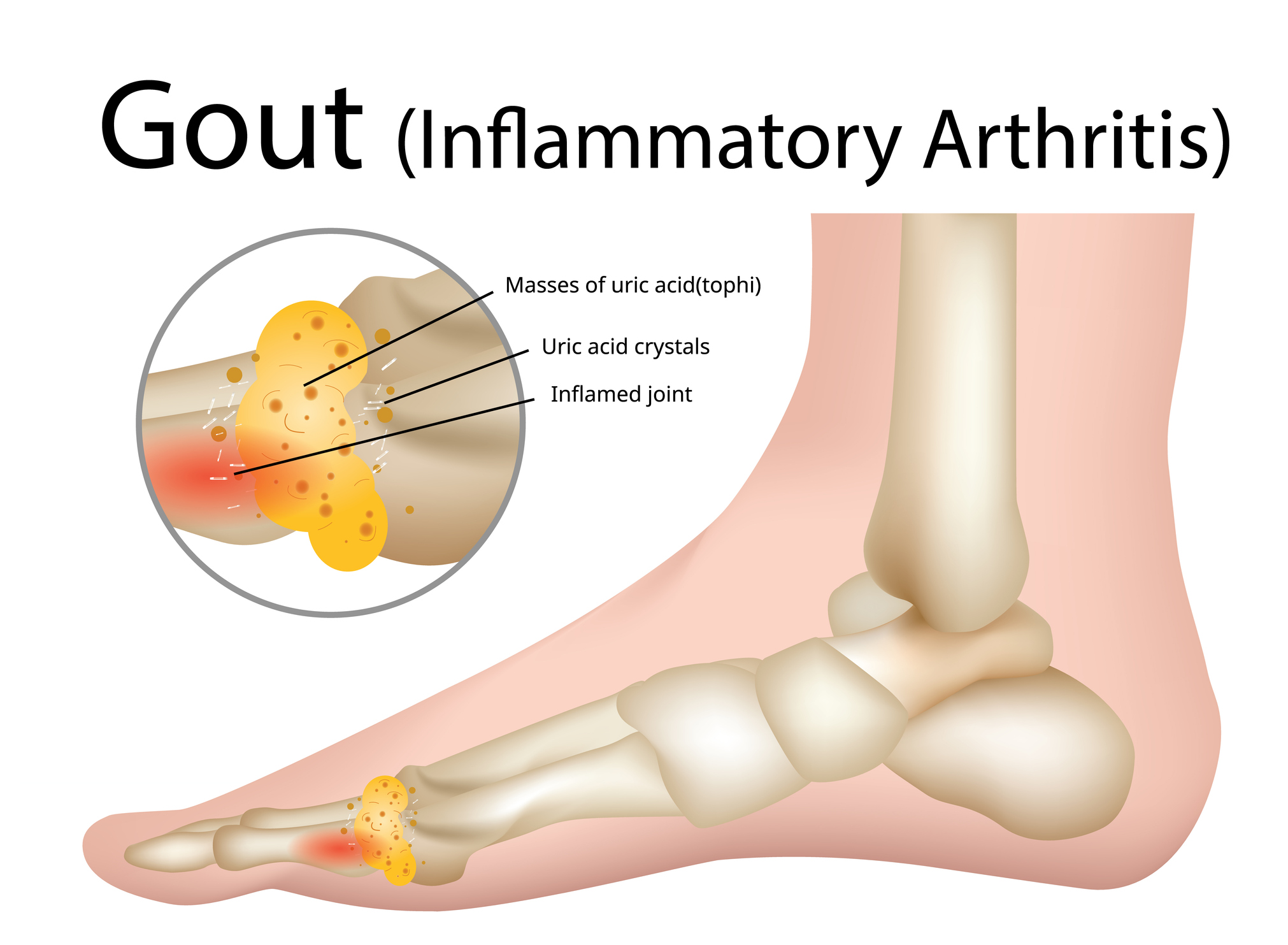
Uric Acid Buildup
The kidneys are the portal through which uric acid is eliminated and if they can’t do it fast enough, uric acid build-up occurs. Several medical conditions, including blood and metabolism disorders, sometimes cause gout by lowering uric acid excretion from the body.
Diet and alcohol use are often factors, as well. Genetics can also play a role, by making a person have a higher propensity for gout. Anything that prevents the body from efficiently processing uric acid or causes the body to produce too much uric acid, such as purine rich foods, can lead to uric acid buildup. Over time, the uric acid will crystallize, initiating the four-stage process of gout.
Other Factors
Obesity, or weight gain, especially in youth and high blood pressure are risk factors for hyperuricemia and gout. Even some diuretic medications (or water pills) and medicines containing salicylate can elevate uric acid levels.
Uric acid is normally produced by the digestion and breakdown of purines. Foods that contain purines and cause excessive uric acid buildup include:
- red meat and wild game, turkey, and goose
- organ meats, such as liver and sweetbreads
- seafood, particularly tuna, shellfish, scallops, sardines, trout. haddock, sardines, anchovies, mussels, and herring
- Sugary foods and beverages, especially ones processed with high fructose corn syrup, such as sodas, syrups and some salad dressings, as well as sweetened cereals, bakery goods and candies
These can make the susceptibility for gout greater, especially in persons who cannot eliminate uric acid efficiently.
Drinking too much alcohol, especially beer, which is rich in guanosine (a purine nucleoside), also leads to uric acid buildup. Alcohol ingestion leads to dehydration, which prevents the body from eliminating uric acid efficiently. As the body starves or dehydrates, uric acid continues to build up in the joints.
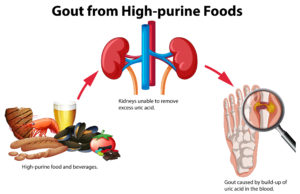
It’s in the Kidneys
Normally, uric acid is excreted from the body through the kidneys. Some people who suffer from hypothyroidism and kidney disorders are at an increased risk of developing gout. The treatments for such disorders often interfere with the body’s ability to process uric acid, not to mention that a kidney disorder can also cause problems with uric acid elimination.
If gout is left untreated, kidney damage can occur, making it more and more difficult to process uric acid, thereby making the gout worse. This becomes a vicious cycle that deteriorates into crippling joint damage and deformity, as well as kidney stones and osteoporosis.
Effective Gout Treatments, Gout Remedies
Most gout requires treatment from a rheumatologist. Treatment plans vary based on a patient’s stage of gout, the severity of the condition and one’s general medical condition. Along with medical treatment plans, a diet of low purine foods and drinking plenty of water is also recommended to give the kidneys a chance to do their job.
Most curative treatments involve oral medications to restore a healthy balance of uric acid in the bloodstream, but this addresses the root of the problem, not necessarily the painful symptoms that remain.
Some doctors may prescribe anti-inflammatory medications or use colchicine to reduce joint pain, while corticosteroids reduce joint inflammation and pain. Colchicine has side effects and drug interactions that not all patients can work with.
Topical Pain Creams
While oral medications address the uric acid buildup, people with gout will still experience pain and swelling in the affected areas. Topical creams are a common choice for relieving these symptoms, because they provide almost immediate gout pain relief.
While oral pain medications may help reduce the pain caused by gout, topical creams offer relief directly at the site of pain – instead of waiting for pills that need to work through the bloodstream to take effect, you get gout relief instantly.
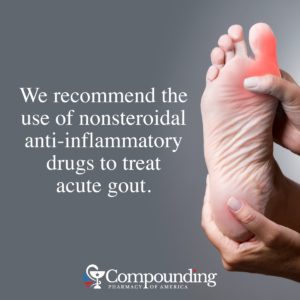
Another benefit of treating gout pain with topical pain creams, is that contrary to oral painkillers, there is no danger of harmful drug interactions. Patients taking multiple medications for medical conditions including gout may not be able to add oral gout medication painkillers to their healthcare regimens.
Topical pain creams work for virtually everyone and have very few side effects when used properly and they are an over-the-counter gout medicine.
Compounded Pain Creams
The Compounding Pharmacy of America understands how valuable topical pain creams are for countless patients looking for effective ways in treating gout pain.
Custom-compounded topical pain creams offer individualized and immediate pain relief. Although adverse side effects are far less common with topical pain creams than oral painkillers, patients can have topical creams compounded to their needs to prevent any potential complications.
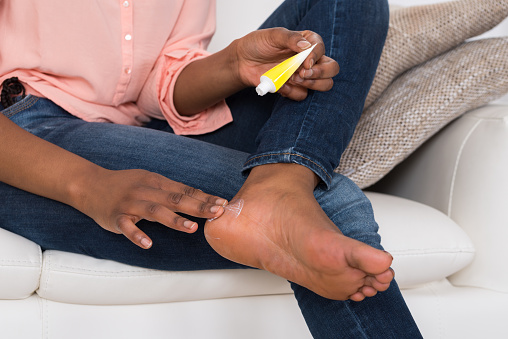
Many patients ask “Can I use lidocaine on my foot for gout pain?” The answer is yes. We can customize a topical pain cream with lidocaine that will work for your gout. Gout may be complex and difficult to treat, but custom-compounded topical pain creams from the Compounding Pharmacy of America offer instant relief from gout-related pain.
Don’t wait for pills to work their way through your bloodstream and risk dangerous drug interactions. Our topical pain cream is over-the-counter gout pain medicine that works instantly. Order custom-compounded topical pain creams to manage your pain quickly, safely and effectively.
